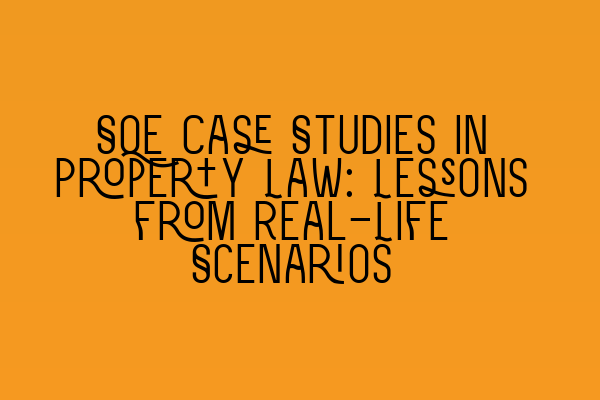SQE Case Studies in Property Law: Lessons from Real-Life Scenarios
Welcome to our blog at SQE Property Law & Land Law! In this post, we will delve into some fascinating real-life case studies in property law and explore the valuable lessons we can learn from them. Whether you are a law student preparing for the SQE exams or a practicing solicitor looking to expand your knowledge, these case studies will provide you with practical insights that can be applied to various property law situations.
1. The Case of Easements
One of the most common areas of property law that often leads to disputes is easements. Easements are legal rights that allow a person to use another person’s land for a specific purpose. Let’s look at a case study to better understand the complexities involved:
Case Study: Smith v Jones (2018)
Smith and Jones are neighboring property owners. Smith has been using a path on Jones’ land to access a public road for over 20 years. However, Jones suddenly decides to block the path, preventing Smith from using it. Smith takes the matter to court, claiming an easement over the path.
Lesson Learned: In this case, the court considered the principle of “prescription,” which allows a person to claim an easement if they can prove uninterrupted use of another person’s land for a specified period of time. Smith was able to demonstrate 20 years of continuous use, making his claim valid.
Understanding Contractual Capacity: Rights and Limitations
2. The Case of Adverse Possession
Adverse possession is another intriguing area of property law that often comes into play. It allows a person to gain legal ownership of someone else’s land by occupying it for a certain period of time. Let’s explore a case study that demonstrates the intricacies of adverse possession:
Case Study: Brown v Green (2016)
Brown and Green are property owners who share a boundary. Brown had been maintaining a garden shed that encroaches onto Green’s land for over 12 years. Green discovers the encroachment and seeks legal action to regain possession of the land.
Lesson Learned: In this case, the court considered the elements required for adverse possession, including open, notorious, and exclusive possession for a specified period. Brown was able to prove continuous use of the encroached land for 12 years, successfully claiming adverse possession.
Interactive SQE Mock Tests for Contract Law: Test Your Knowledge
3. The Case of Leasehold Disputes
Leasehold disputes are common in property law, particularly in the realm of residential property. These disputes often arise from disagreements between landlords and tenants regarding rights, responsibilities, and lease terms. Let’s examine a case study that highlights the challenges faced in leasehold disputes:
Case Study: Taylor v Mitchell (2017)
Taylor is a tenant of an apartment owned by Mitchell. Taylor discovers significant mold growth in the property, rendering it uninhabitable. Taylor withholds rent and demands immediate remediation from Mitchell. Mitchell refuses to take action, leading Taylor to pursue legal action.
Lesson Learned: In this case, the court emphasized the importance of ensuring habitability in leased properties. It recognized the tenant’s right to withhold rent and seek compensation for the breach of the implied warranty of habitability. The court ordered Mitchell to address the mold issue and compensate Taylor for any damages incurred.
Join Our SQE Contract Law Webinars: Expert Insights and Guidance
4. The Case of Boundary Disputes
Boundary disputes are another common issue in property law that can lead to lengthy legal battles. These disputes arise when neighboring property owners disagree on the location or ownership of a boundary line. Let’s explore a case study to better understand the complexities involved:
Case Study: Johnson v Smith (2019)
Johnson and Smith are neighboring property owners with a shared boundary marked by a fence. Johnson believes that the fence is situated on his land, while Smith argues that it is on her land. The dispute escalates, and both parties engage in legal proceedings.
Lesson Learned: In this case, the court examined various pieces of evidence, including land surveys, historical records, and witness testimonies, to determine the true location of the boundary line. After careful consideration, the court ruled in favor of Smith, concluding that the fence was situated on her land.
Contractual Capacity: Understanding Legal Competence in Contracting Parties
Conclusion
These case studies serve as excellent examples of real-life scenarios in property law, offering valuable insights and lessons to both aspiring and practicing solicitors. Understanding the complexities of easements, adverse possession, leasehold disputes, and boundary disputes can be crucial to effectively navigating property law cases.
Contract Law Reforms: An Analysis of Recent Changes
For further learning and preparation for the SQE exams, we invite you to explore our related articles on contractual capacity, interactive mock tests for contract law, and our SQE contract law webinars. These resources provide expert insights and guidance to help you enhance your knowledge and excel in your legal career.
